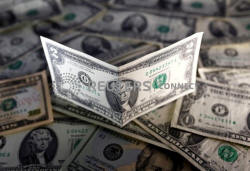Equity rally, U.S. stimulus stalemate keep dollar on
backfoot
 Send a link to a friend
Send a link to a friend
 [August 13, 2020] By
Ritvik Carvalho [August 13, 2020] By
Ritvik Carvalho
LONDON (Reuters) - The dollar fell to its
lowest in a week against a basket of currencies on Thursday, with
analysts pointing to equity market resilience and stalemate over
additional stimulus for the U.S. economy as reasons for its weakness.
After losing 10% of its value from a peak in March, the dollar index has
been bouncing around its lowest levels in more than two years since late
July.
On Thursday, it traded 0.3% lower at 93.093 <=USD>. Against the euro <EUR=D3>,
the dollar fell 0.5% to $1.1840, adding to a 0.4% decline on Wednesday.
Analysts note recent equity market resilience - despite rising
coronavirus cases, the stalemate over a new U.S. relief package, and
geopolitical tensions - only works against the dollar.
U.S. stocks rallied on Wednesday with the S&P 500 index <.SPX> reaching
record highs.

"The S&P500 briefly touched record highs yesterday, confirming the
ability of equities to quickly shrug off negative drivers to sentiment,"
said Francesco Pesole, FX strategist at ING. "This remains a key point
in favour of the dollar-bearish argument."
Risk-on sentiment benefited the Australian dollar, as did
better-than-expected jobs data that eased concerns about a persistent
coronavirus outbreak in the Australia's second-largest city, Melbourne.
<AUD=D4>
The Japanese yen recouped some of its losses from the previous day,
trading 0.3% higher at 106.62 per dollar. But by midday in London it
gave up those gains and traded flat. <JPY=>
The British pound <GBP=D3> rose 0.5% to $1.3099.
The onshore yuan <CNY=CFXS> briefly rose to a five-month high before
steadying at 6.9421 per dollar. U.S. and Chinese officials meet Saturday
to review their Phase I trade deal.
[to top of second column] |

U.S. dollar notes are seen in this November 7, 2016 picture
illustration. REUTERS/Dado Ruvic

President Donald Trump accused congressional Democrats on Wednesday of not
wanting to negotiate over a U.S. coronavirus aid package as Republican and
Democratic negotiators traded blame for a five-day lapse in talks over relief
legislation.
"The question now is whether this will be enough to prompt a slowdown/correction
in the stock rally," Pesole said in a note to clients.
"Latest evidence suggests investors may turn a blind eye to the matter, and the
balance of risks remains tilted to the downside for the dollar today as well."
The pandemic has taken a particularly heavy toll on the United States, where it
has killed more people than in any other country. Millions of U.S. workers have
lost jobs, and supplemental federal unemployment benefits expired last month.
Market sentiment has swung between optimism and pessimism, but analysts argue
that more stimulus is the most likely outcome because without it the U.S.
economic recovery could stall.
Graphic: World FX rates in 2020
https://graphics.reuters.com/
GLOBAL-CURRENCIES-PERFORMANCE/
0100301V041/index.html
(Reporting by Ritvik Carvalho; additional reporting by Stanley White in Tokyo;
editing by Larry King, Kirsten Donovan)
[© 2020 Thomson Reuters. All rights
reserved.] Copyright 2020 Reuters. All rights reserved. This material may not be published,
broadcast, rewritten or redistributed.
Thompson Reuters is solely responsible for this content.
 |